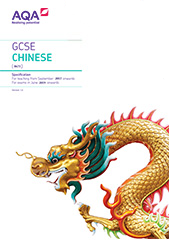3.3 Grammar
The grammar requirements for GCSE Chinese (Mandarin) are set out in two tiers: Foundation Tier and Higher Tier.
GCSE students will be expected to have acquired knowledge and understanding of Chinese (Mandarin) grammar during their course. In the exam they will be required to apply their knowledge and understanding, appropriate to the relevant tier of entry, drawing from the following lists. The examples in brackets are indicative, not exclusive. For structures marked (R), only receptive knowledge is required.
Students will be expected to develop and use their knowledge and understanding of this grammar progressively throughout their course.
Foundation Tier
Nouns
noun suffixes: 子,家,员
Measure words
the following measure words: 个,岁,年,只,天,本,口
with 每 to mean 'every'
Adjectives/ stative verbs
as predicate: positive and negative
with modifiers: 很,非常
modification of nouns with or without 的
with 了 to imply limits have been passed
with 了 to imply a new situation
stative verbs as adverbs (好吃,难学)
Exclamations and interjections
太 … 了
真
Comparatives
use of 比
use of 比较 + adjective
use of 最
use of 跟/和一样 to state similarity
Adverbs
非常,常常,一定,也,还 , 就
Pronouns
all personal pronouns, singular and plural
personal pronouns with 的
demonstrative pronouns 这,那
大家
Verbs
the verb 是 (to be), positive and negative
the verb 有 (to have), positive and negative
simple sentences with verb and object, positive and negative
verb-object type verbs (唱歌,跳舞etc.)
verbs of motion, methods of transport, purpose in coming and going
modal verbs: 会,想,要,应该,可以
future intention: 打算
attitude: 喜欢,爱
actions in progress: 在,正在
requests: 请
completed actions: 了
experiential suffix: 过
complements of direction, degree and manner
Prepositions/ co-verbs
从,到,在,用, 坐
Interrogatives
questions using 吗
choice type questions
questions using 还是
questions using the following interrogatives: 什么,谁,哪儿,为什么, 怎么,几,哪个,什么时候,怎么,怎么样,多少,多大,几岁,
tag questions using 呢,吧
Location
giving location using 在
giving location using 是
positional phrases using 的(墙上的画)
Conjunctions
joining nouns to nouns: 和
saying 'with' 和,跟
subjects in parallel 都
虽然 ….但是……
因为 … 所以 ….
也 …. 也 ….
又 …. 又 ….
先 …. 然后/再 ….
如果/要是… 就 …
一边 … 一边 …
… 的时候
Number, quality, dates and time
all numbers up to 1 million
ordinal numbers using 第
stating quantities
giving the time and date
currencies and prices
giving the length of time
word order when using time expressions
Higher Tier
Nouns
noun suffixes: 儿,者
Measure words
条,家,次,些,杯,张,
reduplication of measure words
Adjectives/ stative verbs
adjectives with 得多/极了/不得了
adjective/stative verb + verb as adjective eg 好吃/好听/好看/难看
Comparatives
comparative sentences with quantities
Adverbs
经常,从来,从来不
Pronouns
自己
Verbs
modal verbs: 得,必须,一定,能
negative of 必须:不用,不必
future intention: 准备
imminent action: 了
use of 得 to describe how an action is carried out
use of 给
reduplication of verbs
iImperatives (positive and negative)
resultative verb complements (看见,看不见)
reported speech: 听说,妈妈说 …
topic/comment type sentence
是 plus stative verb for emphasis
Interrogatives
questions using the following interrogatives: 多远,多长时间,多久
indirect questions
interrogatives used to express inclusiveness/exclusiveness
interrogatives used indefinitely
Location
use of 离 to state proximity or remoteness between two locations
Conjunctions
'Or' in statements using 或,或者
一…. 就 …….
不但 … 而且 ….
除了 …. 以外 …..
越 .… 越 ….
而且
不过
那么
因此
为了
